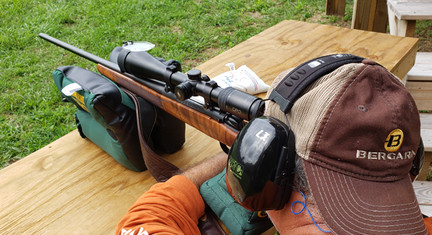Newfoundland Moose Hunt Affords Ample Opportunity to Test Guns & Gear
- By Ken Perrotte
- Nov 21, 2019
- 8 min read
Updated: Nov 9, 2020

A rainy, late September Newfoundland moose hunt this year offered challenging conditions and ample opportunities to try out some new gear.
First, in the shooting category, my hunting companion Bob Ackerman and I brought two Bergara .300 Win. Mag. rifles to the camp. One was the B-14 Timber with the walnut stock that I had previously used in South Africa in the summer of 2015, just after that new production rifle debuted. I took a very nice Southern Greater Kudu with that rifle and it shot like a champ on that hunt. This time, I swapped out the factory trigger (basically, a Remington 700) for a Timney Trigger. I'm no trigger snob but the swap was

worth it, adding a sweet touch of precision and crispness. The rifle was topped with a GPO (German Precision Optics) PASSION 6X 2.5-15x50i scope. GPO is a Midlothian, Virginia, company led by executives formerly with some of the most renowned European optics companies. Their objective is build scopes and binoculars to the standards seen in many European models costing hundreds or thousands of dollars more.
This GPO scope has a 30mm main tube scope. The glass affords excellent clarity edge-to-edge and the light-gathering capability at the end of the day or in early morning is as good as any I’ve ever used and better than most. GPO claims that the PASSION 2.5-15×50 has 15 percent more field of view and 20 percent more zoom compared to similar European premium models.All of the adjustments -- zoom, diopter, windage and elevation, and parallax -- were butter smooth, not too loose -- not too tight. The scope had an illuminated reticle that is controlled on the left side, using the same turret as the parallax adjustment, but the turret is designed well enough that there is no confusing things and turning on the dot and adjusting its brightness is easy. I liked that the dot turns itself off if the unit remains motionless for three hours, preserving the small CR2032 battery.
Quality optics can make or break a big game hunt. The MSRP is $1,349.99 but sometimes you can find them on sale various other retailers. Here are some GPO-provided specs:
Super-zoom 6X technology
iControl illumination options
Internal PASSIONtrac quick-zero turrets
Massive lenses assure optical excellence
30mm main tube
GPObright lens coating technology
PASSIONdrop hydrophobic lens coatings
Double HD objective lens technology
Our GPO 10x42 binoculars were invaluable, at least on the days where the weather let us see more than 100 feet! They have a light transmission rating of 99.7 percent. Tony, my Arluk Outfitters guide, was amazed at how sharp these binocs were as we glassed distant meadows and bogs during the infrequent times when the weather gave us a break. The binoculars sell for $999 and weigh just under two pounds. Here are the other specs:

GPO products carry something they call the "Spectacular Lifetime Warranty." It is pretty darn good, offering a fully transferable warranty with no registration card or proof of purchase required. Any replacement products are of equal or greater value.
Our other rifle was Bergara's new Highlander. We first tried this rifle at the 2019 SHOT Show and loved it. The Highlander, part of the Premier Series line, proved to be a sweet-shooting machine and we were ringing steel plates easily out to 300 yards, the farthest we shot, when we were zeroing the guns. We considered ordering the gun in popular 6.5 Creedmoor but opted for the little more ooomph that the .300 Win. Mag. affords.
The Highlander's fiberglass Grayboe stock was more suited to Newfoundland's rugged, sometimes cold, wet extremes than the B-14 with its oil-finished walnut (although I still think the wooden stock is a lot better looking!). The rifle is light, just under 7.5 pounds but the frame with the full-length fluted barrel handles the .300 recoil with ease, making it a comfortable gun to shoot, even during a 20-plus round session at the range.
Here are Bergara's specs for the Highlander:
Weight: 7.2 lbs-7.7 pounds
Overall Length: 38.5-43 inches
Barrel Length: 20-24-inches
Magazine: Hinged floor plate
Mag Capacity: 4-inch standard, 3-inch magnum
Cerakote Sniper Gray
Trigger: TriggerTech® Frictionless Release Technology™
Barrel Taper: No. 5
Muzzle: Threaded 5/8-24 inches with thread protector
Stock: Fiberglass
Scope Mount: Fits Remington 700 bases with 8 X 40 screws
Bergara guarantees that all Premier Series rifles will produce groups of 1.0 MOA (minute of angle) or less at 100 yards with quality factory match grade ammunition. The MSRP is $1850.
As I noted earlier, the hunt was tough. The weather just didn't cooperate. Ackerman and I both passed on small bulls on the second day, a Tuesday that turned out to be the only day with decent weather. Missourian Jay Simpson tagged out on a nice bull that day. Ackerman opted to take a large cow moose on day 5 of the 6-day hunt. The entire morning had been thick fog and when it finally broke in early afternoon, Ackerman capitalized and pulled the Highlander's trigger. I never had another chance to pull the trigger. When we arrived back in Deer Lake after the hunt, it appeared nearly everyone killed their moose on that Tuesday. The Arluk outfitting and guiding team, though, was stellar and we'll give it another go in 2020.
We used a couple of products to both protect and process the meat. Many hunters have their meat shipped to a processor near Deer Lake, where it is cut and packaged and either picked up by the hunters for the return trip home or drop-shipped to specific pickup points in the United States. We did things a little differently, bringing a FoodSaver GameSaver vacuum sealer to camp along with an array of knives and saws.
I used a Havalon Talon knife kit, as well as some 5-inch Talon saws to cut a tomahawk steak out of Jays's moose. We filmed the process for my friend Scott Leysath's Sporting Chef television show. Interchangeable blade knife systems are increasingly popular. Havalon’s Quik-Change II system has an internal locking mechanism that lets you quickly change blades without losing any cutting area. The whole thing packs into a folding, nylon roll that’s easily carried in your backpack. The $74 kit includes two 3.5-inch gut hook combo blades, a 5-inch fillet blade, a 3.5-inch semi-serrated blade. I added optional ($18) 5-inch Talon bone saw blades to cut through moose ribs. The blades were razor sharp and easily sliced through the fat and meat of the section of moose we were working on.

Arluk Outfitters relies on helicopters to ferry hunters to and from their camps. When possible, moose meat is flown from the camp to the processor midway through the hunt. Usually a couple moose have been taken and taking the meat helps ensure a consistent flow and ready meat at the processing station and that helicopters won't be overloaded weight-wise when it comes time to head home. As I noted earlier, we had rough weather with only day 2 offering a full day of sunshine and clear skies. The plan was to take moose meat out on day 3, but poor weather superseded that notion. Another challenge was daytime temperatures were getting well above 40 degrees, the magic number that accelerates bacteria growth on any hanging meat. Fortunately, we had a
couple Koola Buck antimicrobial game bags. The treated bags, when wrapped snugly against a quarter of meat help retard surface bacteria growth, reducing it up to 8 times better than standard bags, according to the manufacturer. Most of the meat hanging in the camp's meat house were in the bags, which greatly helped since the meat never did make it out until day 5.

The drive from Newfoundland to Virginia with several hundred pounds of moose meat took of two days of nonstop travel. Even though I didn't fill a tag, we were able to help a fellow Virginia hunter in camp by transporting his moose meat back to The Old Dominion, saving him a few hundred dollars in shipping costs. We picked up the semi-frozen meat from the processors in the evening the night we flew back from camp. We had one night in the Deer Lake Motel, a wonderful property with a nice restaurant and bar, before heading to Port Aux Basques for the nearly eight-hour Marine Atlantic ferry crossing to Nova Scotia. The meat that Ackerman had processed in camp and sealed with the vacuum sealer was chilled but unfrozen. Keeping the meat cold was imperative, especially since temperatures would be near 80 degrees once we got south of New England.

In preparation, we stocked up with four 100-liter roto-molded Calcutta Renegade coolers. The meat didn’t seem to thaw at all. I’ve since used one cooler to transfer frozen packs of venison. The meat stayed frozen solid across four days of sitting in the cooler, with no extra ice added. The cooler has an oversized drain plug and features a built-in 100 lumen LED light. The coolers have a freezer-style lid with a gasket, stainless steel hinge pins, rope handles with oversized grips and rubber latching. The interior can be divided by a cutting board that slides into place. It also has a storage basket, similar to many chest freezers. The retail price is $449 or about $50 cheaper than a comparable sized Yeti. And, they have a 5-year warranty. The full line of Renegade coolers runs from 20 to 125 liters.

When it came to clothing, the key was to dress in layers. Every hunt necessitated some sort of climb to higher ground. It was easy to break a sweat. Vegetation and the ground was always wet in the morning so you needed to ensure you had rain gear on, even if it wasn't raining. But, rain it did - often. The first day was a near washout with driving rain and wind. The third day had wind and sleet. That was the day that told me my rain gear wasn't cutting it. I'm not going to get into a brand name here because so many brands have the same style of garment, a waterproof membrane with some sort of brushed twill "silent" outer covering. The problem with this outer covering is it often holds water versus shedding it. Water may not permeate the membrane, although it did in the seat of my pants after a couple of hours of sitting, but it does conduct the cold directly against whatever garment you have under the rain gear. After hours in such conditions, you can't stay warm. A better choice would have been one that doesn't have any brushed twill or similar exterior, but rather a solidly impermeable, water-shedding surface. There are many such options on the market and when I return to Newfoundland next year, I plan on giving one of them a test.

Beneath the rain gear, though, I had ScentLok's Revenant mid-to-late season pants and jacket. These were super comfortable and did a good job fighting the wind and chill. A Cabela's windstopper sweater beneath the jacket also aided immensely. I'm not sure Cabela's makes these anymore; I'm on my second sweater in 20 years - that's probably why.
The ScentLok brand has been around for many years. Their odor-control process involves blending activated carbon, treated carbon and zeolite (minerals sometimes used as drying agents, in detergents, and in water and air purifiers) concealed between fabrics. The particles adsorb odors, holding on to them until they're released in a hot clothes dryer. The suit had a windproof membrane and an outer finish to help it shed water. Warmth is provided by a mix of interwoven long nap fleece & polyester fabric and Thinsulate insulation. The jacket has a safety harness opening to allow the harness to be worn beneath the jacket with the strap accessible to the exterior. Between the thin long underwear, the sweater and the ScentLok jacket and pants, the layering was sufficient to meet the condition on most days.
I brought two pairs of boots with me: some Lowa GTX Evo Extreme leather boots I used in British Columbia a couple years ago and some new Woody Max 18-inch waterproof boots by Muck Boots. There really wasn't any other option. The ground, with its many bogs, deep cushions of lichen, water-filled potholes (some as deep as your waist or more) and abundant creeks and runoff areas mandated nearly knee-high, completely waterproof boots. The Woody Max ($200) has an aggressive, molded lightweight outsole, an EVA molded midsole with contoured, internal footbed, a 5mm flex-foam bootie with stretch nylon and a fleece lining. They slipped on and off easily and were, for the most part, comfortable to wear. They did get put through their paces, as it were. One thing I did notice is that the terrain and frequent climbing and descending sometimes saw one of my heels moving a bit in the boot, creating friction. This was quickly remedied with a couple band-aids beneath my Darn Tough socks. The boots are still in play, now heavily engaged in Virginia’s deer season.



















Comments